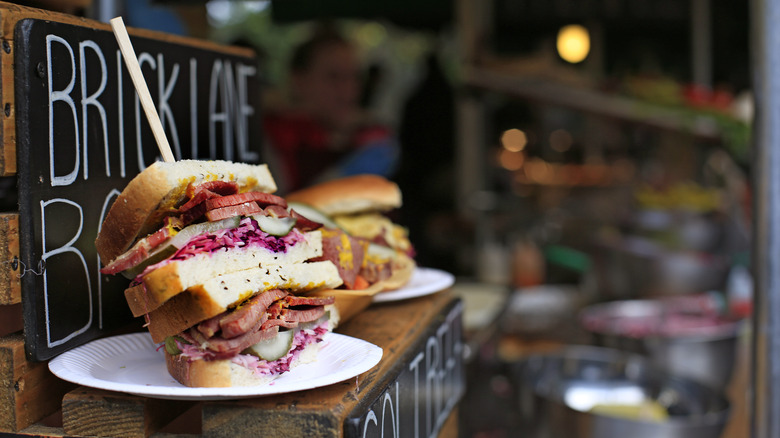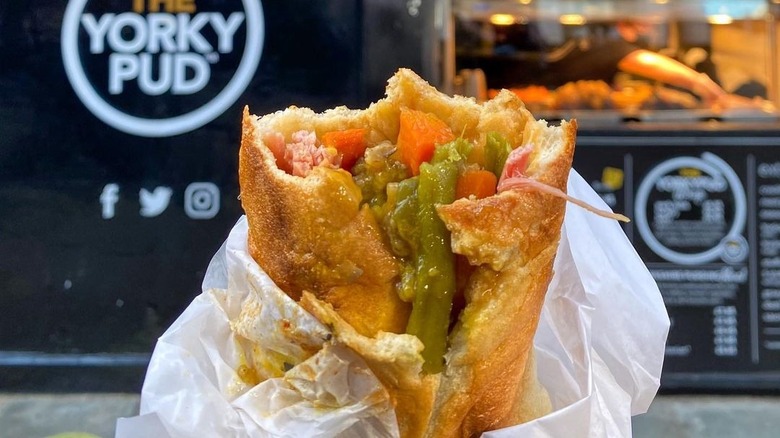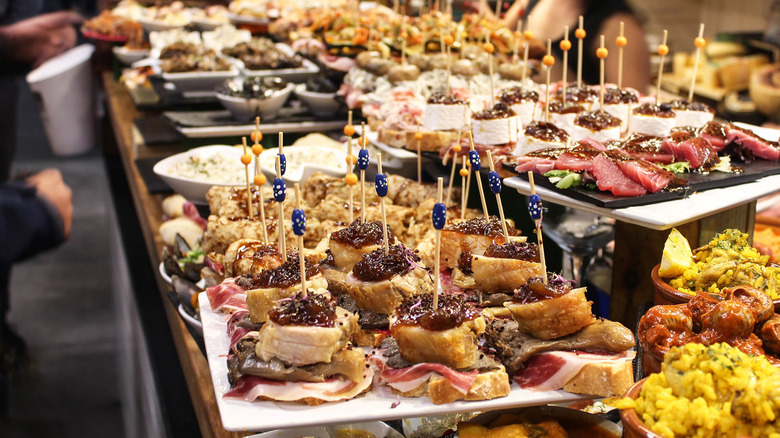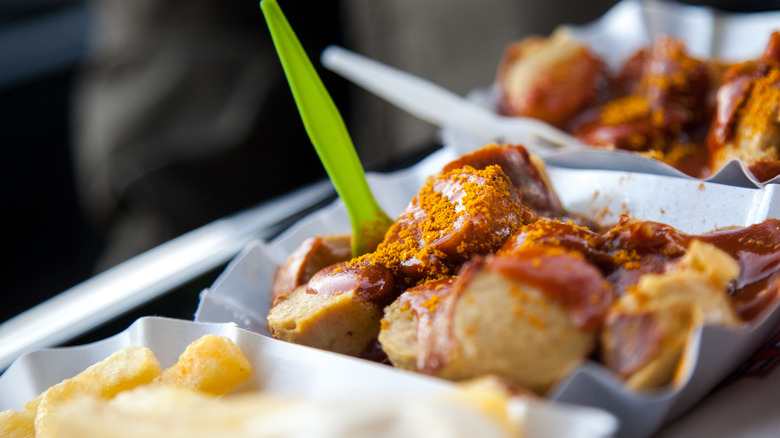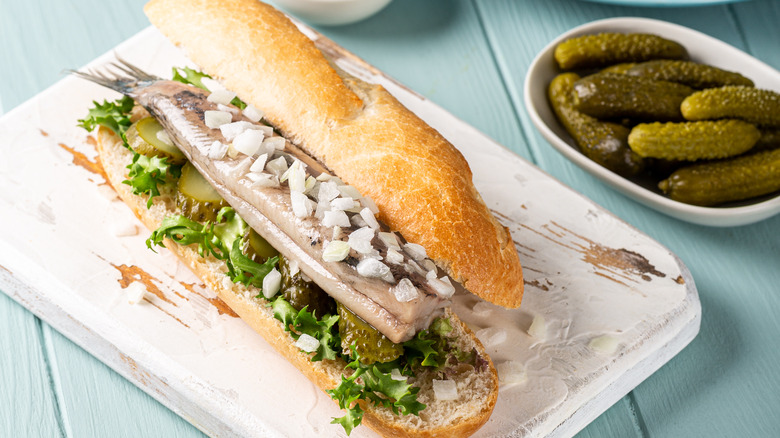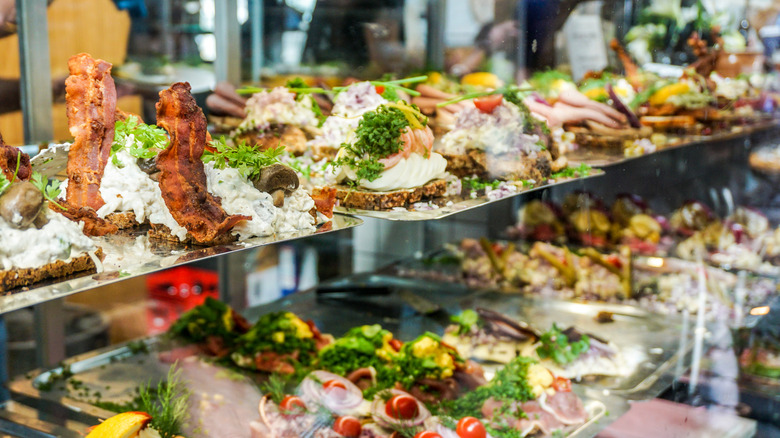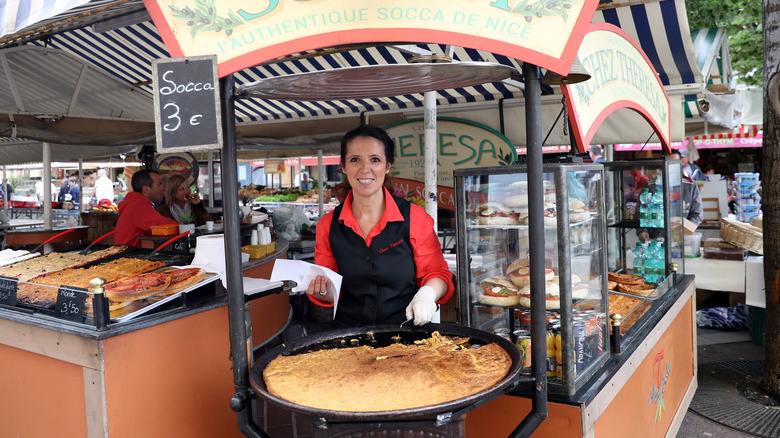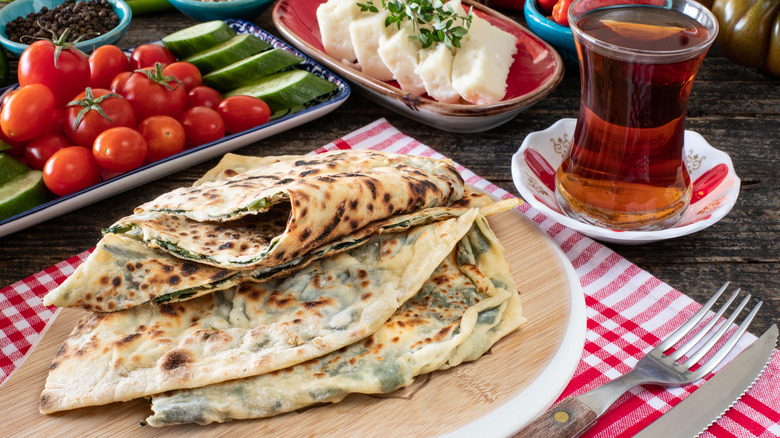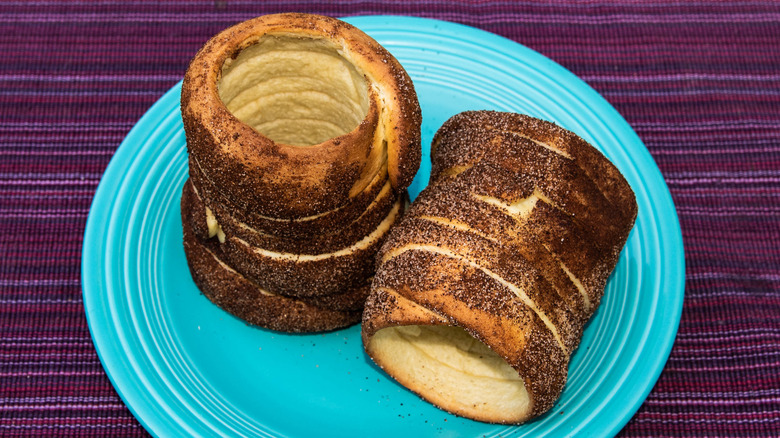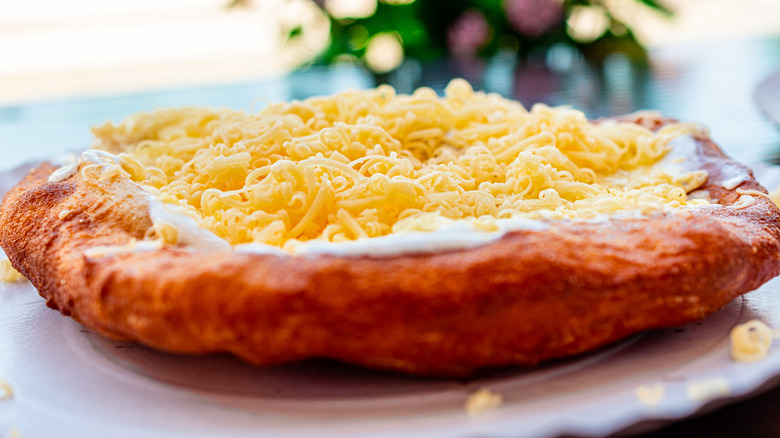Iconic Street Foods You Can Only Find In Europe
The historic streets of Europe hide many secrets that tourists find far too tantalizing to ignore. Centers of revolution and battlegrounds as well as countless iconic buildings often seen on screen are made real. All indicate a culture that is within comprehension, a society that could perhaps be fully understood despite the short duration of a holiday.
But the architecture — no matter how old, grand, or sweeping — is not what defines this illustrious continent. Neither is the carefully plated food served in pristine restaurants, indicative of the society that created it. To find the elusive heartbeat of European culture you would do better to look past the towering spires and white tablecloths and turn your gaze toward the street. Here, you can start to become a part of the culture.
Street food, created and sold by the continent's constituents, offers not only a means of prolonging this experience but of enriching it too. All five senses are immersed in a uniquely European moment that could not be recreated elsewhere.
Yorkshire pudding wrap - England
Speak to many English people and they will tell you that Yorkshire pudding is the highlight of their weekly Sunday roast. In fact, so beloved is the airy, crisp, batter-based pudding that the first Sunday of February has been coined National Yorkshire Pudding Day in the U.K. (per National Today).
You can imagine the bedlam then when The York Roast Co cafe in the English city of York started selling YorkyPud™ Wraps; a full Sunday lunch served inside a giant rolled-up Yorkshire pudding. As reported by The Guardian, lineups stretched along the street as the small cafe churned out over 1,000 wraps a day.
Since its creation in 2017, the Yorkshire wrap mania has not subsided and multiple stalls sell the lauded street food across the nation, including at London's famous Camden Market where it goes by the name Yorkshire burrito. Ever keen to maximize profits, supermarket giant Aldi released its own version of the Sunday lunch burrito, per The Evening Standard, but aficionados will tell you that nothing can beat The York Roast Co's original YorkyPud™ Wrap.
Pintxos - Spain
The common description of pintxos as Northern Spain's version of tapas is a great disservice to this wholly unique culinary offering. Born in the Basque Country, pintxos are small dishes presented on countertops, often intended to be self-service (per Eusko Guide). Assorted ingredients are commonly served upon a base of bread with a toothpick thrust through for stability. Served in every taverna and bar across North-Eastern Spain, pintxos have come to typify the area's cuisine, and are enjoyed by tourists and locals alike in the cobbled streets that wind through cities and towns.
This is no more widely exemplified than in pintxos' birthplace, Donostia-San Sebastián (via The Culture Trip). A regular evening will see a huge array of people enjoying award-winning and possibly even Michelin-starred pintxos with a refreshing caña (beer) in hand. Such a wholehearted embracement of street food culture is hard to find elsewhere in the continent. This enthusiasm marks Spain as a unique champion of the gastronomic subculture.
Zapiekanka - Poland
Street foods that quickly become national emblems are common in Europe. Think of England's fish and chips served in a soggy newspaper or Belgian waffles whipped up before you on the streets of Brussels. But for Polish people, their national street food is not one that at first glimpse appears distinctly Polish thanks to the inclusion of a rather conspicuous French baguette.
Zapiekanka, a baked baguette stuffed with mushrooms and melted cheese, owes its Gallic appearances to a license that enabled Polish companies to produce French baguettes themselves in the '70s (per Culture.Pl). Mushrooms and Tilsit cheese were used to stuff the baguette, and thus zapiekanka was born.
Its comforting satiating nature combined with its cheap price led to a peak in popularity during periods of economic difficulty in Poland (via Travel Food Atlas). But demand for zapiekanka has remained, in part due to nostalgia, but also because the stuffed baguette is so adaptable. Multiple street stalls sell variations of it, usually finished off with ketchup as Taste Atlas describes, ensuring anyone can enjoy this Polish classic.
Currywurst - Germany
Created during the turmoil and scarcity of post-World War II Berlin, currywurst marries traditional German bratwurst with a tomato-based sauce and curry powder (per NPR). The invention of currywurst is attributed to the late Herta Heuwer, who supposedly came up with the concoction after executing a series of trades with British soldiers stationed in the city, as The Culture Trip reports. The dish proved such a hit that Heuwer's street food stand stayed open until 1974.
Berlin's favorite street food is now widely available across Germany, although the most impressive iterations are still found in the capital. Interestingly, discrepancies in currywurst remain prominent throughout Berlin due to the implications of the now defunct Berlin wall. When the city was divided in two, those in the East could not obtain sausage casings, resulting in cooks making currywurst with skinless sausages. These crumblier variations are still prevalent in those districts today, as opposed to the crisper skin-on variations found in the capital's West (via NPR).
Broodje haring - The Netherlands
Sushi with its artistically crafted spirals of rice, fish, and vegetables has done wonders for the popularity of raw fish in Europe. Once a popular street food itself, as per The Guardian, sushi has become so iconic that its trademark characteristics have become the general expectation for raw fish dishes across the continent. That is, everywhere outside of The Netherlands.
Here, the country has a longstanding affinity for slightly more robust raw fish delicacies. Most notably, you'll quickly come across the street food icon broodje haring. This dish is composed of raw cured herring served in a soft bun topped with raw diced onion and pickles (per Taste Atlas).
So, about as far from the delicate flavors of sushi as you could get. Yet there is a method in the madness; the crunch of raw onion highlights and contrasts the herring's soft texture. Unfortunately, it's worth knowing that the salt cure does not entirely eliminate the potential health risks associated with eating raw fish (per Healthline).
Smørrebrød - Denmark
Much like America, Europe seems to have a longstanding obsession with sandwiches. In 2017 Britain's sandwich industry was worth £8 billion (per The Guardian), while in 2019, Foodism labeled sandwiches as London's hottest food trend. Yet, Britain's craze for the gargantuan New York deli-inspired subs is not the only type of sandwich taking the continent by storm.
Smørrebrød, Denmark's stunning open-faced sandwiches, are a street food craze perfect for Instagram influencers and discerning gourmands alike. Built upon rectangles of seed-dense sourdough rye (per Serious Eats), smørrebrød quickly becomes a work of art as toppings are piled high. Like any sandwich, smørrebrød is highly customizable, but there are some classics recommended for first-timers. Prominent amongst them is leverpostej, a liver pate made from pork liver and lard. To cut through the richness of the spread, this particular smørrebrød is usually topped with pickled vegetables such as beets (per Scandinavia Standard).
Smørrebrød is rapidly growing in popularity outside Denmark and the aesthetically pleasing lunch item is becoming a popular fixture in cafe windows and restaurant menus across Europe (per The Culture Trip). There are even signs that the deli-obsessed British may be getting behind smørrebrød. The quintessentially Danish lunch got some prime television time when it was featured as a challenge on the 2018 installment of The Great British Baking Show (via Great British Chefs).
Poffertjes - The Netherlands
There must be some innate human instinct that draws us towards frying dough, because pancakes — in one form or another — are hugely popular across all cuisines. From the dosas of India to the msemen of Morocco and of course, America's own fluffy variant, our love for this simple treat knows no bounds. Within Europe, there are multiple versions and perhaps the cutest are poffertjes.
These small Dutch treats are traditionally made with buckwheat flour, as Dutch Poffertjes explains. Not to mention, they are a regular feature of markets across The Netherlands (via Britannica). The tiny pancakes are cooked in cast-iron molds over high heat. In sensible pancake fashion, butter is usually placed atop hot poffertjes, followed by a liberal sprinkling of icing sugar (via Dutch Poffertjes). The sweet garnish goes some way in counteracting the slightly bitter taste of buckwheat. All the same, many contemporary cooks prefer to utilize plain flour during the cooking process to suit a wider range of palates.
Socca - France
Another pancake-like creation that has proved widely popular as street food is naturally wheat-free socca. This chickpea-based delicacy originated in the French city of Nice and has been a street food staple for centuries (per The Culture Trip). In modern-day Nice, socca is often transported from kitchens to market squares by cyclists. You'll also find it cooked directly on-site at stalls located throughout the city. Each area has seen its fair share of socca sellers, but Térésa, a vendor who started trading in Cours Saleya market way back in 1928, has proved to be the most popular in living memory (per The Good Life France).
What makes socca stand out from other similar dishes is the subtle natural sweetness imparted by chickpea flour. This ensures that it is predominantly eaten without the array of toppings usually associated with other types of pancakes. A drizzle of good quality olive oil and a pinch of salt will usually suffice (per The Culture Trip).
Gözleme - Turkey
Gözleme is an Anatolian dish that probably has as many variations as there are villages on the peninsula (per Daily Sabah). Yet, despite these discrepancies, all of its variations are created in the same manner. Traditionally, the dough contains no yeast and is rolled out and covered with fillings (per Recipe Tin Eats). These can range from minced lamb to vegetarian alternatives like spinach and cheese, according to Taste Atlas. The dough is then folded over itself to seal the ingredients inside before being fried.
Usually cut into slices and eaten both as a snack and for breakfast, the fried flatbread takes on a pleasant texture with plenty of crunch giving way to a hot and flavorsome filling. Recently, Turkey has seen aspects of its culture soar in popularity thanks to the large influx of foreigners. Gözleme is one such example, having gone from a breakfast associated with rural communities to being served on even the busiest streets of Istanbul (per World Food Story).
Cornish pasty - England
To become popular, street food needs to both taste great and be served in a manner that makes it possible to eat on the go. After all, what good is a delicious meal if you don't have the means of consuming it? One solution to this conundrum is to cover food with pastry, however, early iterations of pies and pasties often involved pastry that was not even meant to be eaten (via BBC). Yet, as gastronomy developed, this ancient alternative to Tupperware gradually gave way to the edible pastry casings we recognize today.
Pastry ingenuity reached new levels with the Cornish pasty; an all-in-one meal associated with hungry Cornish tin miners. According to Taste Atlas, the nourishing preparation typically contains beef and root vegetables. The Cornish Pasty Association notes that the pastry's unique shape and ridge-like crust were developed so that miners could easily hold their pasty without spreading arsenic from their hands onto their food. Other theories disagree with this idea, and although arsenic poisoning is not a concern for most people today, Cornish pasties still retain their trademark shape.
Kürtőskalács - Hungary
Sometimes referred to as chimney cakes, kürtőskalács are a popular sweet treat in a number of countries, namely Hungary, the Czech Republic, and Slovakia (per Taste Atlas). Made from an elastic yeasted dough (per Karen's Kitchen Stories), kürtőskalács get their unique shape from the traditional wooden dowels used to cook the dough. The pastry is frequently drenched in melted butter and can be covered in granulated sugar which creates a crisp outer shell. However, the most unique facet of kürtőskalács is that they are cooked over an open charcoal fire in a traditional spit-roast method (via Taste Atlas).
The first written record of kürtőskalács is found in the 1781 cookbook "Treasure House of Womanly Wisdom" by Transylvanian countess Mária Mikes de Zabola (per Kurtos Kalacs). Despite its age, the sweet treat has remained popular across Europe, and many other spit-roasted iterations such as Sweden's spettekaka and Germany's baumkuchen are thought to be closely related to it. Most celebrated of all the spit cake variants is Slovakia's skalický trdelník, which has been awarded protected geographical indication by the European Union (per GOV.UK).
Simit - Turkey
Appearing to be a cross between a pretzel and a bagel, simit is a savory sesame bread-like ring that has been a stalwart of Turkish street food since the 1500s, per Turkish Cuisine. The outlet notes that ever since, simit sellers have been a common feature of Turkish cities, namely in Istanbul where over 2.5 million simits are sold daily. Interestingly, simit can also be used as a vehicle to track the different waves of migrants that have made Istanbul their home.
As reported by Turkish Cuisine, simit bakeries have changed hands multiple times since the 1940s, and the majority are now owned by families originating from Tokat in central Turkey. The acquisition of the bakeries by migrants from Anatolia has influenced the type of simit available across the capital as food historian Nejat Yentürk explains to Culinary Backstreets: "The new owners were unfamiliar with the simit culture of Istanbul and wanted to make simit more cheaply in order to cope with economic difficulties. They started dipping the simit in cold diluted molasses rather than boiling them, which saved time, energy, and manpower." He notes that simit made in the traditional method boiled in molasses is still available under the name gevrek.
Lángos - Hungary
Once again, we dive headfirst into the fatty world of fried dough, a world that lángos embraces wholeheartedly. This dish makes no attempt to appear healthy, which would be a futile claim since to the untrained eye it looks like a deep-fried pizza. And in some instances, it is. While the disk of deep-fried dough is usually smothered in smoked cheese or sour cream, it can also be topped with common pizza ingredients (per Taste Hungary).
Undoubtedly a dish of excess, lángos has long been associated with curing hangovers, Atlas Obscura describes. Some enterprising Hungarians have attempted to modernize the recipe so that it can compete with popular Western European cuisines (per Taste Hungary). Lángos has even received a very American makeover with a burger variation at Korzo, a Brooklyn restaurant serving Central European food. As reported by Bud News, the patty is served in a deep-fried lángos bun and quickly became a mild internet sensation after Food Network released a video on Facebook, revealing the step-by-step process that goes into making this monstrous meal.
Pastizzi - Malta
The small archipelago of Malta located in the Mediterranean Sea has been exposed to an incredible variety of cultures throughout its history (per Britannica). Amongst other aspects of life, the mixing of the native Maltese with a wide array of other populations has greatly impacted the local cuisine (per Visit Malta). These influences are apparent in pastizzi, a popular type of street food and the country's national snack (per A Maltese Mouthful).
Pastizzi are flaky pastries that can be stuffed with a number of fillings, chief among them being ricotta or mushy peas (the latter probably a remnant of Britain's occupation of the island). In order not to get the two pastries confused, unique folding patterns are used to seal the dough depending on the flavor, per Guide Me Malta. The outlet notes that pastizzi are so popular that they have even worked themselves into the Maltese language, with sayings such as "selling like pastizzi" being commonplace. Eaten at all times of the day, the flaky treats are a true Maltese delicacy that exemplifies the nature of street food: fast, cheap, and utterly delicious.
